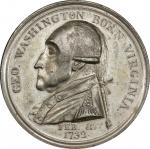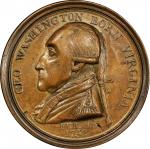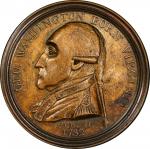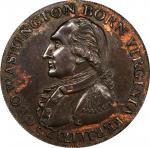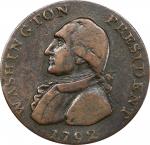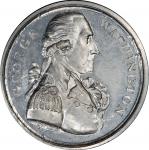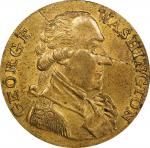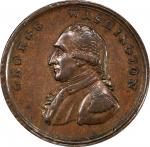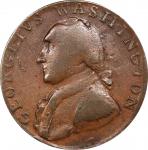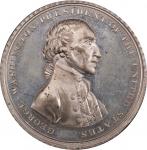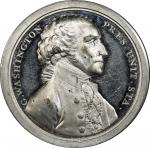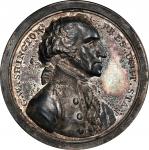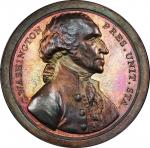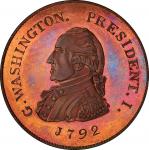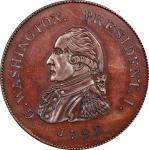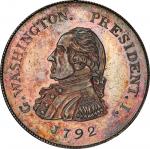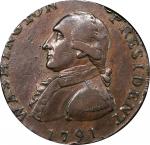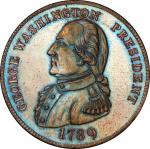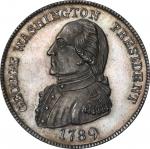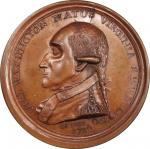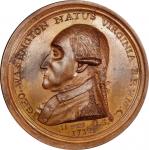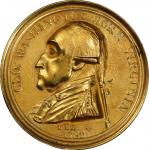1792 Washington President Half Dollar pattern. Eagle and Stars Reverse. Musante GW-31, Baker-20. Silver. Edge lettered, UNITED STATES OF AMERICA +. VF Details—Plugged (PCGS).31.1 mm. 168.5 grains. Pierced for suspension just above Washingtons head and neatly plugged sometime prior to 1877, similar to the silver Getz half dollar offered previously. Medium steel gray dominates the fields while a small area of blue-gray patina is noted extending from just left of Washingtons face upward through the final letters of his name. The higher areas of the motifs have taken on a lighter silver gray tone in a pleasant, yet soft contrast to the fields, serving to accentuate the design features. Fortunately, these design features remain quite sharp overall, the coin having been nicely struck and not too aggressively handled. A few tiny nicks and a couple of hairline scratches are the only impairments beyond the noted plug, and the eye appeal is really rather decent. The portrait is nicely detailed and the legends and date are full, while nearly all of the shield lines and eagle feathers are clearly visible. The centering is slightly imperfect, with the dentils long and sharp in some areas and shorter in others, but they completely encircle the design on both sides.
The first roster of specimens for this variety in silver that we are aware of appeared in Sylvester Crosbys 1875, <em>The Early Coins of America</em>. Therein, he listed examples in the collections of William Sumner Appleton, Charles Ira Bushnell, Lorin G. Parmelee and A.S. Jenks. We can directly trace three of these coins today:
1.John McCoy (Woodward, May 1864) - William Sumner Appleton (1905) - Massachusetts Historical Society Collection.<p>2.Charles I. Bushnell (S.H. and H. Chapman, June 1882) - Lorin G. Parmelee (New York Stamp & Coin, June 1890) - S.H. and H. Chapman - Colonel Green - B.G. Johnson - Eric P. Newman - F.C.C. Boyd - John J. Ford, Jr. (Stacks, May 2004) - Donald Partrick.<p>3.A.S. Jenks (Cogan, April 1877) - William Spohn Baker (d. 1897) - Historical Society of Pennsylvania.<p><p>In 1875, Crosby indicated that both Bushnell and Parmelee owned examples, but as this was several years before Parmelee would purchase the Bushnell specimen, it seems clear that there is a fourth specimen in Crosbys listing that today has an undeciphered line of ownership. It was likely sold off by Parmelee as a duplicate sometime between 1882 and 1890, but we do not know which specimen this is. There are two others confirmed, which remarkably, after more than a century, represents the discovery of just one new piece in all that time.<p><p>4. Ellis and Doris Robison (Stacks, February 1982) - John L. Roper, 2nd (Stacks, December 1983).<p><p>5. The plate coin in the Krause reprint of <em>Medallic Portraits</em> - The plate coin in the Rulau-Fuld revision of <em>Medallic Portraits</em> - Probably George Fuld - Richard Picker - Eric P. Newman (Heritage, November 2018).<p><p>There have been additional appearances of pieces over the years, but considering that the number known has remained quite steady over such a long period of time, it is highly likely that they are additional appearances of one or more of the five listed above. The most recent to sell was the Newman coin, in November 2018. Prior to that it had been 14 years since the Ford specimen was sold. The Newman piece was a bit sharper than this one, called Extremely Fine, but with graffiti. It sold for $204,000, nearly twice what the Ford coin realized 15 years ago-a testament to the enduring appeal of this rarity. Interestingly, 2018 also included the sale of the unique <em>gold</em> impression from these dies for an incredible $1.7 million.
These dies are believed to have been engraved by famous Newburyport, Massachusetts artisan Jacob Perkins, and any specimen from them in <em>any</em> <em>metal</em> is an important early American numismatic prize. With the unique and recently sold gold example out of grasp for most collectors, in consideration of price, this silver piece represents an ideal opportunity to own a rarity that most major collections have not included. It is also the first chance any private collector has had to own this one (with clear title) since sometime prior to 1897, and it is possible that it has not sold publicly since 1877. It carries with it perhaps the most esteemed provenance any collector of Washington medals could hope for - to the passionate collector and researcher who <em>made it all possible</em>, William Spohn Baker.
The provenance of this piece goes back to the April 1877 sale by Edward Cogan, where it was offered as lot 690 and fortunately, plated. That sale was unnamed, but at least two copies exist with the consignors identity hand-written on the cover. One reading "Jenks," the other "A.S. Jenks of Philadelphia," the latter we have used in our provenance. In George Fulds 2008 study of the Getz half dollars, he incorrectly assigned this provenance to an example of the Getz half dollar, his specimen #16, giving the identity of Jenks as William J. Jenks. In Q. David Bowers <em>American Numismatics Before the Civil War</em>, William J. Jenks (also of Philadelphia) is the only Jenks cited. We do not have further information on A.S. Jenks, but as the auction catalog seems to have been named and priced in contemporary penciled hand, we assume it to be accurate.<p>Ex A.S. Jenks of Philadelphia, Edward Cogans sale of April 1877, lot 690 where it was plated, and likely sold directly to William Spohn Baker for $101; William Spohn Baker Collection, to the Historical Society of Pennsylvania by bequest, November 15, 1897; lost by theft in the 1970s; unknown parties; Jules Steinman; Steve Ivy; NASCA, April 1981, lot 2471; Returned to the Historical Society of Pennsylvania, August 1987.


